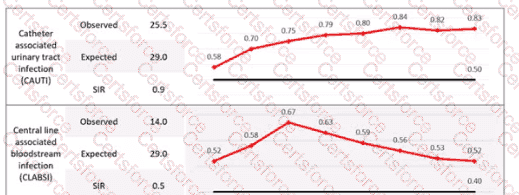The question pertains to key variables missing in a graph that tracks infection rates for benchmarking purposes. The options provided suggest various combinations of data that could potentially be missing, impacting the interpretation of the graph.
Option A suggests a need for historical data and specific denominators, but it doesn’t address immediate contextual needs like timeframe or source/target lines.
Option C introduces external hospital expected rates and modes of data points, which might not be directly relevant to interpreting a specific organization’s infection rate trends.
Option D focuses on qualitative aspects like patient quality and compliance with handwashing protocols, which are essential but not directly related to interpreting graphical data.
Option B is verified as correct because it highlights two critical elements: “the timeframe for each data point” and “the source (or target line).” These elements are fundamental to understanding any graph as they provide context regarding when the data was collected and what benchmarks or standards are being compared against.
The timeframe is essential to identify trends over time, seasonal variations, or impacts of specific interventions or changes in practice.
The source or target line provides a benchmark indicating expected performance levels or goals that the organization aims to achieve.
Without these two pieces of information, it would be challenging to derive meaningful insights from the graph about infection rate trends and their implications for future benchmarks.
[References:, HQ Solutions: Resource for the Healthcare Quality Professional, Fifth Edition, Chapter 5: Quality Review and Accountability, p. 133-134, Learning Lab: Survey Readiness – A Team Approach to Success, Slide 8: Data Display, Learning Lab: The Role of the Healthcare Quality Professional in Population Health Management, Slide 10: Data Visualization, , , , , , ]

Submit